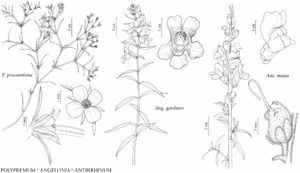Antirrhinum majus
Sp. Pl. 2: 617. 1753.
Stems terete, 3–8(–15) dm, glabrous or sparsely stipitate-glandular proximally, stipitate-glandular distally. Leaves: blade narrowly elliptic to lanceolate, 50–70 × 5–20 mm, glabrous or sparsely stipitate-glandular proximally. Inflorescences stipitate-glandular, sometimes glabrous; bracts similar to distal leaves. Pedicels 1–7 mm, stipitate-glandular. Flowers: sepals 5–10 mm, stipitate-glandular; corolla palate yellow; filaments 20–40 mm. Capsules 7–10 mm wide. 2n = 16 (Europe).
Phenology: Flowering May–Oct.
Habitat: Disturbed ground.
Elevation: 0–2000 m.
Distribution
B.C., Ont., Que., Calif., Conn., D.C., Ill., Iowa, La., Mass., Mich., Mo., N.Y., Ohio, Oreg., Pa., Utah, Vt., Va., Wash., Wis., sw Europe, introduced also in Mexico, West Indies, Central America, South America, Asia, Africa, Australia.
Discussion
Antirrhinum majus is a popular garden plant grown as an annual; it occasionally escapes but is short-lived. Some cultivars have been developed with different growth forms, corolla colors, or open-throated flowers.
Selected References
None.
